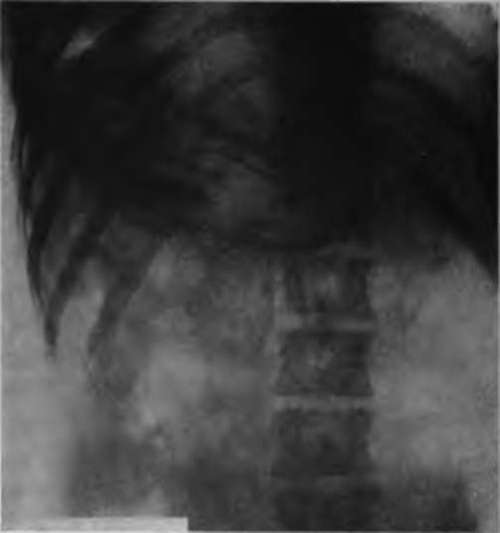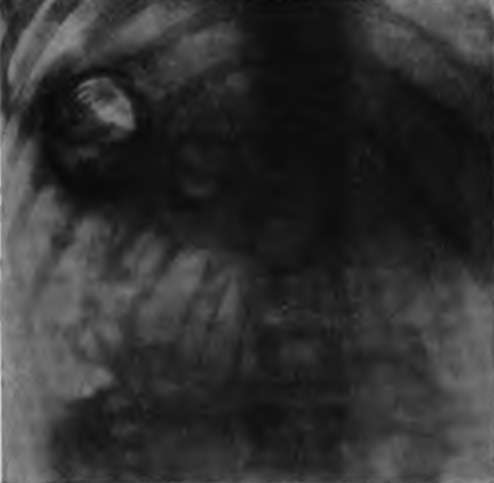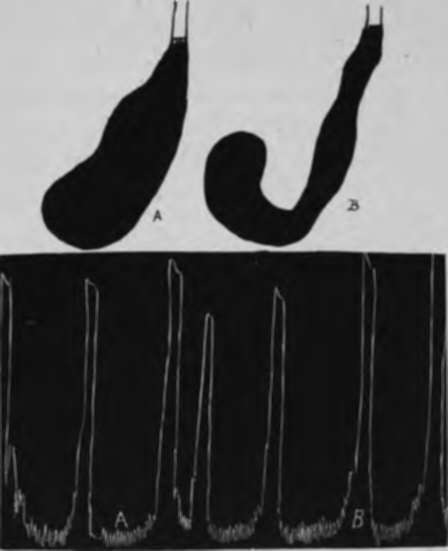Chapter IV. The Stomach In Hunger. I. Relation Between Digestion Contractions Of The Filled, And Hunger Contractions Of The "Empty" Stomach
Description
This section is from the book "The Control Of Hunger In Health And Disease", by Anton Julius Carlson. Also available from Amazon: The Control of Hunger in Health and Disease.
Chapter IV. The Stomach In Hunger. I. Relation Between Digestion Contractions Of The Filled, And Hunger Contractions Of The "Empty" Stomach
As we have seen in the case of the rabbit and the guinea-pig and the goat, the digestion contractions of the filled gradually pass into the hunger contractions of the empty or nearly empty stomach. In the frog and the turtle the digestive peristalsis of the filled stomach is practically identical with the hunger peristalsis of the empty stomach. What are the conditions in man and the higher carnivorous mammals ? Is it likely that the situation is different in animals with a stomach always more or less filled with food and in animals with a stomach usually empty before they experience hunger?
To answer this question Rogers and Hardt, working in the author's laboratory, used the two standard methods of investigating the movements of the stomach: the rubber balloon and the X-ray methods. The balloon was swallowed shortly after a meal, and continuous graphic records of the intragastric pressure variations were made until after the onset of a typfcal hunger period. Soon after eating an average meal the subject of the experiment swallowed the balloon and put himself into a comfortable position, either sitting in a chair or lying on a cot. The results were similar, irrespective of the position; the best results were obtained while the subject was asleep.
In order actually to see the hunger movements, we coated a balloon with a bismuth paste and observed its movements in the stomach with the X-ray. These balloons were prepared by painting the outer wall of one with a paste made of bismuth subnitrate and vaseline. This balloon was then inclosed in another of the same size; hence the two balloons were separated by a thin wall of bismuth paste. One is thus able to make graphic tracings with simultaneous direct fluoroscope observation.
Our records show that the fundus is quiescent immediately after a large meal has been eaten. The pressure upon the balloon is maintained at a steady level. If a light meal is taken, the tonus variations may be demonstrated immediately after eating. At first they are so slight as to seem insignificant, but they increase in vigor and are usually visible 30 minutes after the meal. In one experiment an unusually large meal was eaten and the tonus waves were distinctly in evidence 20 minutes later. They increase in intensity and may, but do not always, become more rapid. Each wave is of 1 to 3 minutes' duration. When the stomach is nearly empty (as determined by the stomach tube or induced vomiting) they become conspicuous, and at this stage of the digestion there usually appear, superposed upon them, stronger contractions which increase in vigor and are felt by the subject as hunger pains. Although it is by no means always the case, it is significant that the first contractions felt as a hunger pang in man may occur when the stomach still contains traces of food.
Fig. 9.-Tracing showing the tonus rhythm of the stomach (man) 3 hours after dinner (beefsteak, spaghetti, bread, butler, apples and cream, milk).
We have seen that the onset of a hunger period is marked by the appearance of a slow tonus rhythm which gradually increases in vigor and culminates in the hunger contractions. This tonus rhythm is present, not only as an immediate precursor of the hunger period, but also throughout the course of normal gastric digestion.
Other workers have employed the rubber balloon in recording the digestion movements in the stomach, but none of the published tracings, so far as we are aware, indicate the presence during normal digestion of the slow continuous rhythm here described. Moritz reported contractions of the fundic end of the stomach occurring 2$ to 3$ times per minute. According to DicUan the time required for the peristaltic contractions of the pyloric end of the stomach is 20 to 24 seconds. The tracings of Moritz probably record the intragastric pressure variations due to the pyloric peristalsis. Sick, using the balloon method, describes tonus variations of the fundic end of the stomach which give rise to the peristaltic waves. These occur at the rale of 2 to 4 per minute in the full or empty stomach. The tracings of Sick show three kinds of pressure variations: respiratory, cardiac, and "Magen tonus schwangungen," the latter averaging 20 seconds each in duration. The duration of these "stomach tonus variations" coincides with the time intervals required for the pyloric peristalsis.

Fig. 10, A.-X-ray photograph of the ap|>carnncc of the bismuth-coated balloon in the stomach (man) when the empty stomach is quiescent.

Fig. 10, B.-X-ray photograph of the bismuth-coated balloon in the stomach (man) at the height of a gastric hunger contraction (gastric hunger pang) (Rogers and Hardt).
Is the hunger contraction simply an augmented peristaltic contraction or a contraction of the fundus as a whole? To answer this question the stomach movements of the dog and in man were studied by the "balloon-X-ray" method. We were able to make direct observations of the movements of the balloon in the stomach and at the same time to note the character of the graphic record. The upper part of the balloon was held in the cardiac end of the stomach. A young and vigorous dog was employed for the experiments. The dog was starved for intervals of 36 to 48 hours, and in order not to have the hunger contractions completely inhibited by the excitement attendant upon the X-ray examination, frequent repetitions were made until the dog became accustomed to the necessary manipulations. The vigor of the stomach contractions thus made visible to the naked eye is surprising. The weaker type of hunger contractions begin as a constriction in the cardiac end of the stomach and pass down toward the pyloric end as a rapid peristaltic wave. In the very vigorous contractions the wave spreads over the stomach so rapidly that it is difficult to decide whether there is a contraction of the fundus as a whole or a very rapid peristalsis. This contraction may well be compared to the peristaltic rush of the intestine as described by Meltzer and Auer.
The balloon-X-ray observation of the hunger contractions was made on Mr. R. when in a reclining position. When a hunger pang was felt, and the recording manometer showed the typical rise in the intragastric pressure, a series of constrictions were seen passing rapidly over the balloon. Beginning at the cardiac end, they swept rapidly toward the pyloric end, increasing in strength as they proceeded. It was readily seen that the hunger contractions are powerful peristaltic contractions, which, arising at or near the cardiac sphincter, swept downward over the entire stomach. During a typical hunger period the stomach exhibits movements which resemble very closely the movements which have been described by some clinicians in patients after a bismuth meal as hyperperistalsis, but described by Cole as normal peristalsis of a stomach that contains small quantities of food. Observations on the dog were made after 36 hours of deprivation of food, on man after 15 hours. Prolonged starvation in the case of the dog was necessary to overcome the inhibitory influence of the excitement attendant upon the X-ray examination. Whether or not the stomach of man after a long period of starvation would show a condition approaching that described for the dog, we are not in a position to state.
The current teaching with reference to the part played by the fundus during digestion is that it is a reservoir, exerting a tonic grasp upon its contents. The kinematographic figures of the stomach published by Kastle, Ridder, and Rosenthal show that the fundus is not quiescent during digestion. Cole has shown that when food is in contact with the cardiac end of the stomach in man, contractions begin in the fundus and frequently are as deep in this region as in the pylorus. According to Forsell, with the subject in the standing position, the fundus shows no peristalsis. In the reclining position there occur typical peristalses of the fornix. At the conclusion of gastric digestion there occur circular contractions of the wall.

Fig. 11.-Hunger contractions of the dog's stomach 30 hours after a meal.
A, outline of bismuth-coated balloon in stomach between the gastric contractions;
B, outline of balloon at the height of a hunger contraction (Rogers and Hardt).
It is thus evident that the digestion contractions of the filled stomach pass gradually over into the hunger contractions of the empty stomach. This explains how the hunger sensation may be aroused by the stomach contractions before the stomach is actually empty. It is merely a question of intensity of the fundus contractions. But it is still true that the digestion contractions are primarily concerned with the pyloric end of the stomach, while the hunger contractions of the empty stomach are initiated at the cardia and involve the entire stomach.
Continue to:
- prev: IX. Contractions Of The Empty Stomach Of Amphibia And Reptilia
- Table of Contents
- next: II. Origin Of The Hunger Sensation
